Rain Gardens
Rain gardens are an easy way to return water to our aquifer, reduce erosion, and help prevent stormwater runoff.

In natural landscapes, rainwater soaks back into the soil and down into the aquifer. But with increasing development, soil is covered with impervious surfaces such as pavement and cement. Rainwater funnels across these surfaces into our waterways, taking pollutants with it.
Running down the driveway or patio, rainwater can pick up lawn chemicals and pesticides before washing into storm drains or bodies of water. But a rain garden can help prevent this from happening, facilitating natural processes that help conserve water and limit pollution.
A rain garden is basically a low section of the landscape planted with native and/or Florida-Friendly plants that like to get their “feet” wet. The garden collects rainwater temporarily, giving it a chance to “strain” out impurities before draining into the aquifer.
They work best when they’re placed at the bottom of downspouts or naturally low spots in the landscape, usually where water tends to puddle. They’re especially useful for collecting runoff from paved surfaces.
A rain garden can be any size or shape, but be mindful to place it at least 10 feet from your house to prevent water from seeping into the foundation. Do not build a rain garden within 25 feet from a septic tank or well. The depth should be around 4 to 8 inches; anything deeper could become a breeding ground for mosquitoes. Before you start digging, make sure to call 811 to find out if there are any underground utilities in that area.
Plants for Your Rain Garden
When selecting plants, you’ll need to consider how much sun your rain garden will get and how much space is available. Include different types of plants to create a complete and cohesive look that will provide year-round interest. Certain species can even attract beneficial insects, birds and other wildlife.
Make sure you select plants that are not just water tolerant, but also drought tolerant for the times between rains. Successful rain gardens rely on tough plants that will survive dry spells but then soak up excess stormwater during Florida’s rainy months, preventing the water from running across your landscape.
Here are a few species that work well in rain gardens:

Blue flag iris (Iris virginica) is a native flower growing 4 to 7 feet tall and 1 to 3 feet wide. Its gorgeous lavender-blue blooms rise up above light-green foliage in spring. This iris can be planted year-round in USDA Hardiness Zones 8b to 11.

Swamp sunflower (Helianthus angustifolius) is a native species that adds a cheerful pop of color with its sunny yellow blooms throughout the fall. The flowers are especially attractive to bees and butterflies, making this a perfect pollinator plant for your rain garden. Swamp sunflower can be grown in hardiness zones 8b to 10 and reaches 2 to 6 feet in height (sometimes taller).
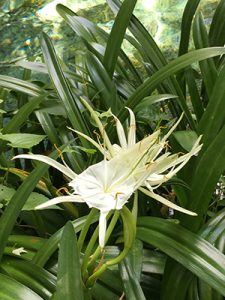
Spider lily (Hymenocallis latifolia) has long, slender green leaves and fragrant, long-lasting white flowers. It blooms in the summer and fall and reaches 2 to 3 feet tall. This clumping perennial grows in hardiness zones 10 to 11.
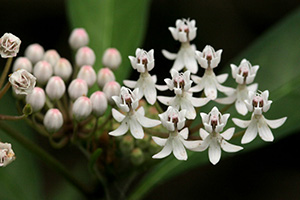
Aquatic milkweed (Asclepias perennis) sports small white flowers and grows roughly 1 to 2 feet tall and 1 to 3 feet wide. It can be found in forests and along streams in the wild. This plant supports local pollinators as a host plant for butterflies. Aquatic milkweed grows in hardiness zones 8b to 9b.
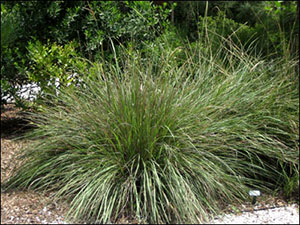
Fakahatchee grass (Tripsacum dactyloides) has tall, green, grass-like foliage rising upright to form clumps that are between 4 and 6 feet tall and wide. The leaves have small, sharp teeth along their edges. The inconspicuous flowers appear in late spring and can be white, pink, yellow or rust colored. This native can be grown in zones 8 to 11.
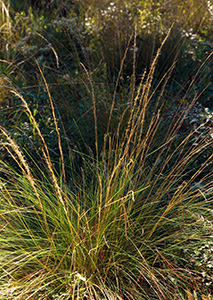
Wiregrass (Aristida beyrichiana) is a common understory cover in longleaf pine forests. This native grows in dense, spreading tufts with long, thin, wiry leaves. It reaches about 1.5 to 3 feet tall and features tiny white flowers.
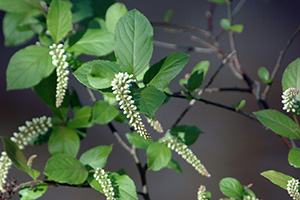
Virginia willow (Itea virginica) is a larger option for your rain garden, growing 3 to 8 feet tall and 2 to 4 feet wide with graceful arching branches. Also called Virginia sweetspire, this native shrub blooms in the spring and summer, with tiny white flower clusters arranged together on a stem. Virginia willow thrives in zones 8a to 10b.
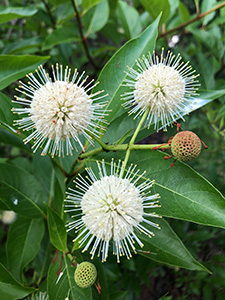
Buttonbush (Cephalanthus occidentalis) attracts hummingbirds, butterflies and bees to its white globe-shaped flowers. This native shrub or small tree can get quite large, growing up to 10 feet tall and 6 to 8 feet wide. It grows naturally in freshwater wetlands, making it a perfect addition to your rain garden. Buttonbush thrives in zones 5 to 10.
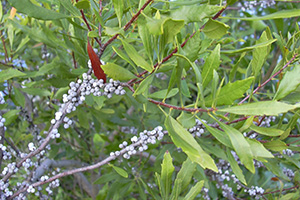
Wax myrtle (Morella cerifera), also called southern bayberry, is a native evergreen shrub or small tree known for its blue waxy berries that can be melted to produce candles. It is a hotbed for wildlife, both as a host plant for butterflies and a source of food and shelter for birds. Wax myrtle is hardy in zones 7 through 10.
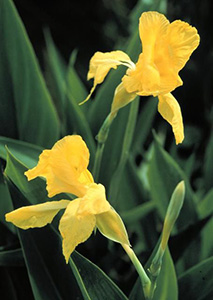
Golden canna (Canna flaccida) can be found in most counties throughout Florida. This wetland species is useful as an ornamental landscape filter, as it removes excess nitrogen and phosphorus from water. It usually grows up to 4 feet tall but has been known to reach up to 9 feet. The clustered, bright yellow flowers are about 3 inches across and have a long bloom period.
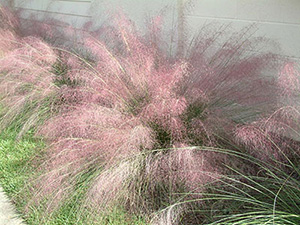
Muhly grass (Muhlenbergia capillaris) is an easy-to-grow ornamental grass that produces clumps that can reach 2 to 3 feet tall and 3 feet wide. In fall, it produces tall, fluffy pink to purple flower stalks. A lovely white-flowering form is also available. This native grows in hardiness zones 7 through 11.
These plants and others perform vital services that benefit our water supply and maintain the health of Florida’s water bodies. To create a rain garden, visit your local garden center or plant nursery. And for more questions on rain gardening, contact your county UF/IFAS Extension office.
